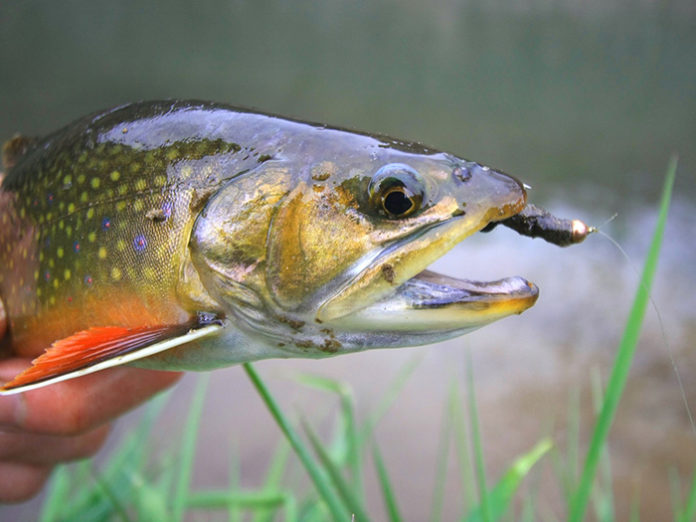Written by: Kip Vieth, Wildwood Float Trips
This gorgeous Driftless Area brook trout fell for a Turkey Leech.
Photo by Kip Vieth
As the snow melts and the spring creeks of the Driftless Area start to settle down, every fly angler in or near this unique region starts to twitch. Spring fever is at a fever pitch, and fly fishers are looking for any excuse to shake off those nasty wintertime doldrums. Many anglers daydream of sitting on the banks of their favorite spring creek, soaking up that early-season bright sunshine. The warmth of the sun and the tug of a spring-creek trout seem to make everything right in the world. Here is a list of my Top 10 flies for fishing these waters, patterns that are sure to help scratch that Spring Fever itch.
1. Black X Caddis, sizes 14-20
Small black caddisflies represent the first major hatch of the season. The trout seem to lose all self-control and will strike with wild abandon. When the trout are keyed in, the whole stream seems to be on fire. When you hit this one right, it is why we fly fish. The trout will do their part and make you feel like the world’s greatest fly angler.
2. Turkey Leech, sizes 4-10
The Turkey Leech (also known as the Grey Leech) might be my all-around favorite fly for the Driftless Area. You can do everything with the fly, and it fishes all season. Strip it, swing it, or just dead-drift it under an indicator. It is the most life-like, pulsating, fish-catching fly I have ever used. I even tie it in bigger sizes and use it on my smallmouth trips later in the year.
3. Pink Squirrel, sizes 14-18
It’s the fly that made the Driftless famous. Enough said. If you’re going to fish the Driftless, you need to have some.
4. Parachute Adams, sizes 14-20
When the blue-winged olives start hatching, it’s always good to have a bunch of these classics in the fly box. In my opinion, it’s the best all-around dry fly ever invented.
5. Prince Nymph, sizes 10-16
I caught my first trout in the Driftless on a Prince Nymph. It will always hold a special spot in the fly box for me. It is still getting the job done some 30 years later.
6. Black PT Nymph, sizes 14-18
There are a lot of little black stoneflies in most Driftless spring creeks. A Black PT Nymph imitates them perfectly. If fished small enough, it also can double as a Baetis Nymph. A great all around pattern when starting your day.
7. Sparkle Dun BWO, sizes 16-20
This is a great cripple pattern. Spring-creek trout can get a bit picky, and when they start turning their noses up at a Parachute Adams, this is the one I reach for. It fishes nice and low in the water, and that is sometimes all it takes to get noticed.
8. Zebra Midge, sizes 18-22
If you’re going to fish the spring creeks early, you need to have a good midge pattern. The Zebra is once again a pattern that keeps proving itself over and over. I like to grease the leader a bit and fish the fly in the film.
9. Sparkle Minnow, sizes 2-10
This is one of my aggressive streamers. I love to throw this fly at the lunker structures, trying to pull the big beasts out. There are a lot of big fish in these small creeks that people never see because they don’t throw the meat. Throw meat if you want to get the big browns to move.
10. Coulee Cranefly, sizes 16-18
As the early season days get longer and warmer, the crane flies make their appearance. These awkward flies bounce around the like some old Deadhead jamming to Jerry Garcia. When they start their dance, the trout join them for a nice meal. If you start seeing those real splashy rises, chances are they’re keyed up on the cranes.
If you’re going to explore the beautiful spring creeks of the Driftless Area, these flies will get you started down the right path. There’s no better time to enjoy these impressive little gems than spring. Get out and enjoy the weather and beauty of some of the world’s finest Spring Creeks.
Kip Vieth is a former Orvis Trout Bum of the Week who owns Wildwood Float Trips, in Monticello, Minnesota. Check out his excellent “10 Tips for Catching a Musky on a Fly.”
Credit: Source link































